A tea from Fumio Maeda
Three green teas freshly brought form Japan, from renowned merchants Kaburagien, Kubotaen and Azumaen. Includes a stellar tea blended by celebrity teamaster Fumio Maeda – and man, is it good!
Three green teas freshly brought form Japan, from renowned merchants Kaburagien, Kubotaen and Azumaen. Includes a stellar tea blended by celebrity teamaster Fumio Maeda – and man, is it good!
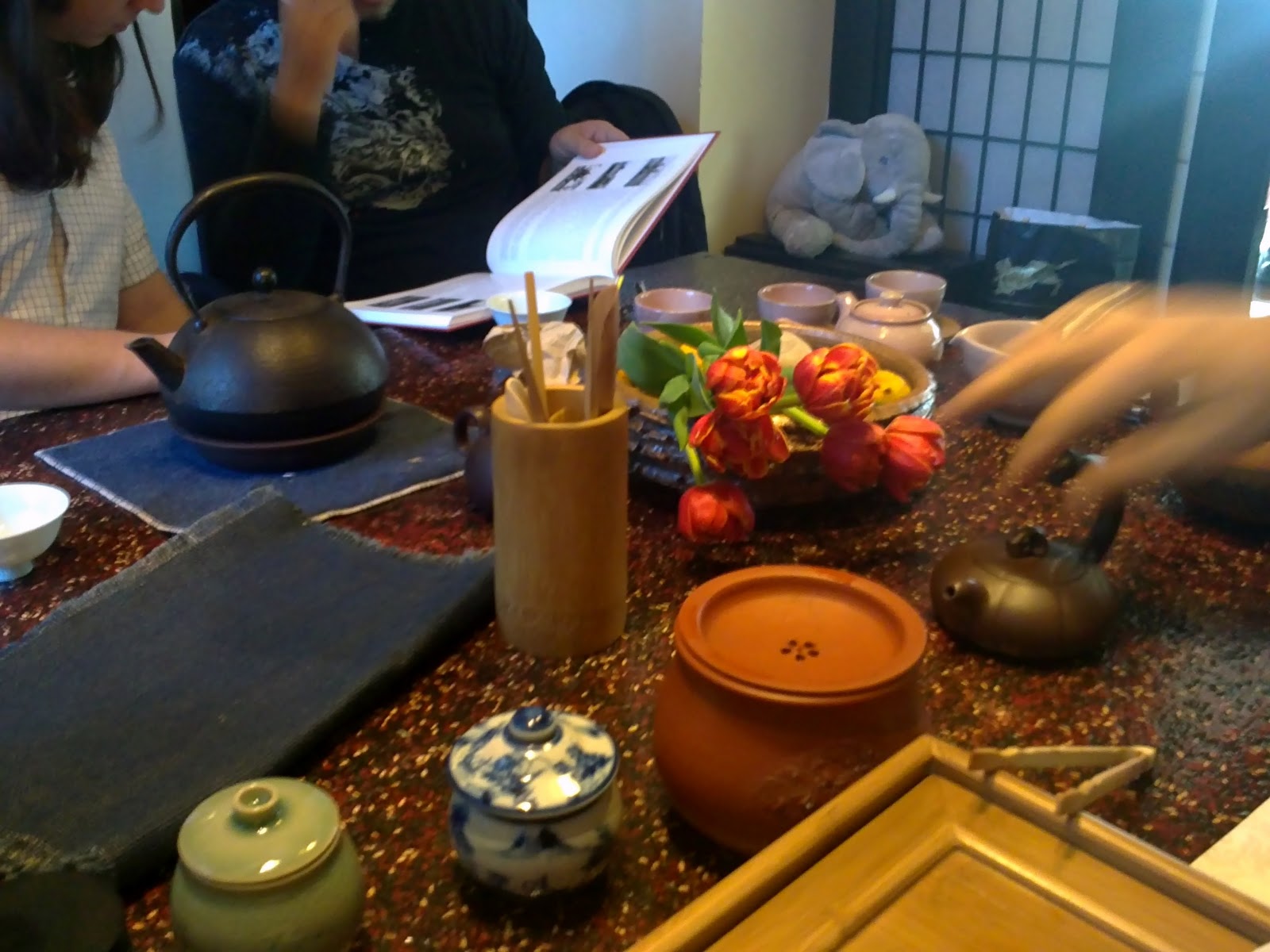 |
| Tea sessions at restaurants are always messy… |
 |
| Nice leaves to this green sejak from Korea. |
 |
| This terrible mobile phone photo is the only one I managed to take of the Jiri-san Balhyocha. |
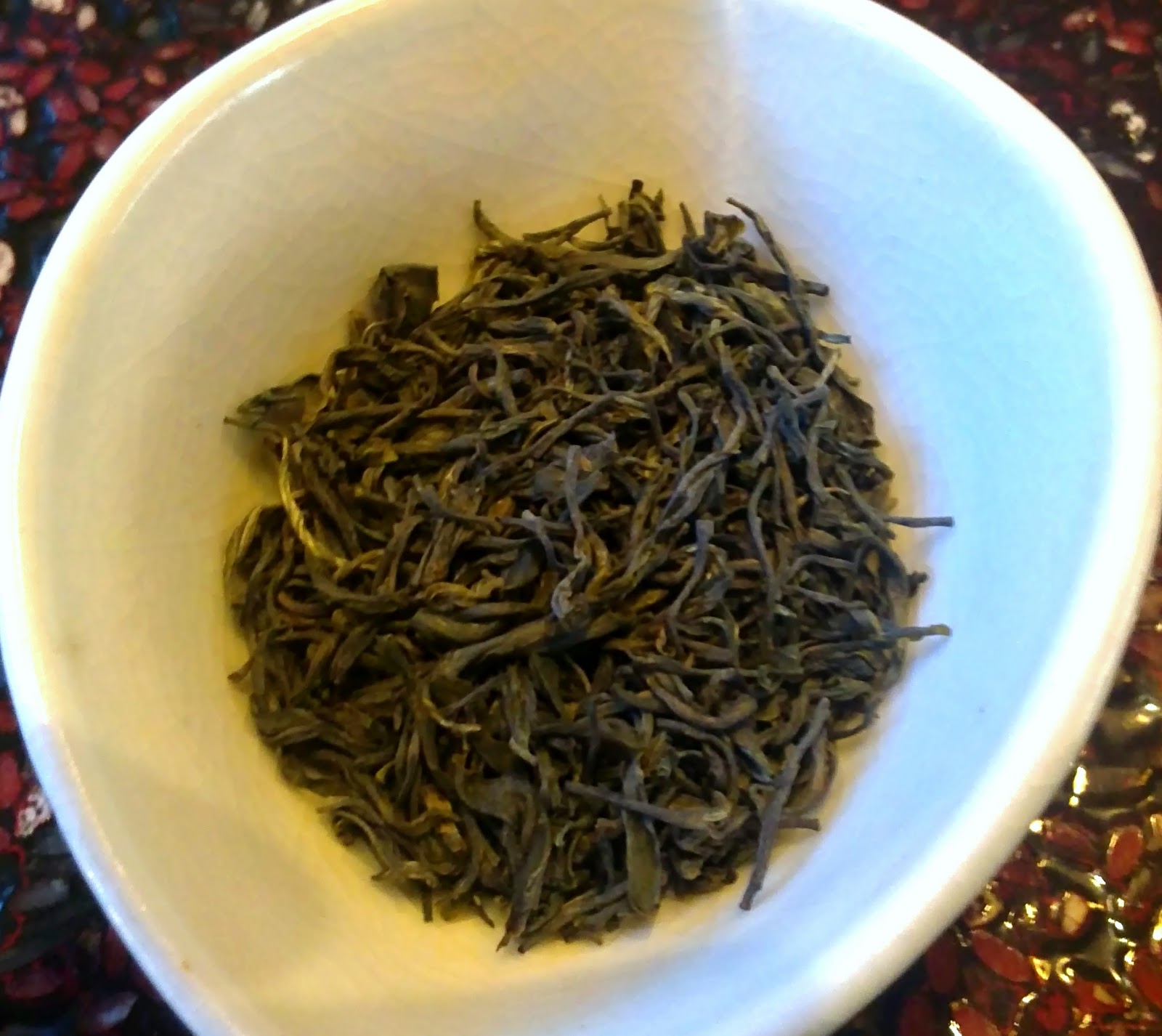 |
| We also had a look at some tea items, including this antique yixing pot: so dirty inside it’s no more good for actual brewing. |
Generally I dislike cold tea. I prefer to drink it fairly hot, and while there’s interest in sheng or oolong tea that has cooled down a little, I find room temperature tea really a little repulsive. So the idea of preparing ice tea required overcoming a bit of self-resistance. I started my trials with the type of tea I drink regularly in the summer anyway: Japanese green. It might be a weird choice for some – intuitively a tea drinker might be wary of overinfusing a sencha leaving it, as you should with ice tea, over several hours on the leaves. In my experience it’s enough to opt for a lighter, less fragmented leaf type like the 3rd Prize Asamushi from Hirumaen (reviewed here). I still had a bit of this left when receiving the new vintage and so using it for ice tea sounded sensible. The result is surprising. There’s a lot of texture to this ‘Iced Asamushi’ with all its glutinous umami character, but also some sweetness. It’s immensely refreshing in a vegetal sort of way.
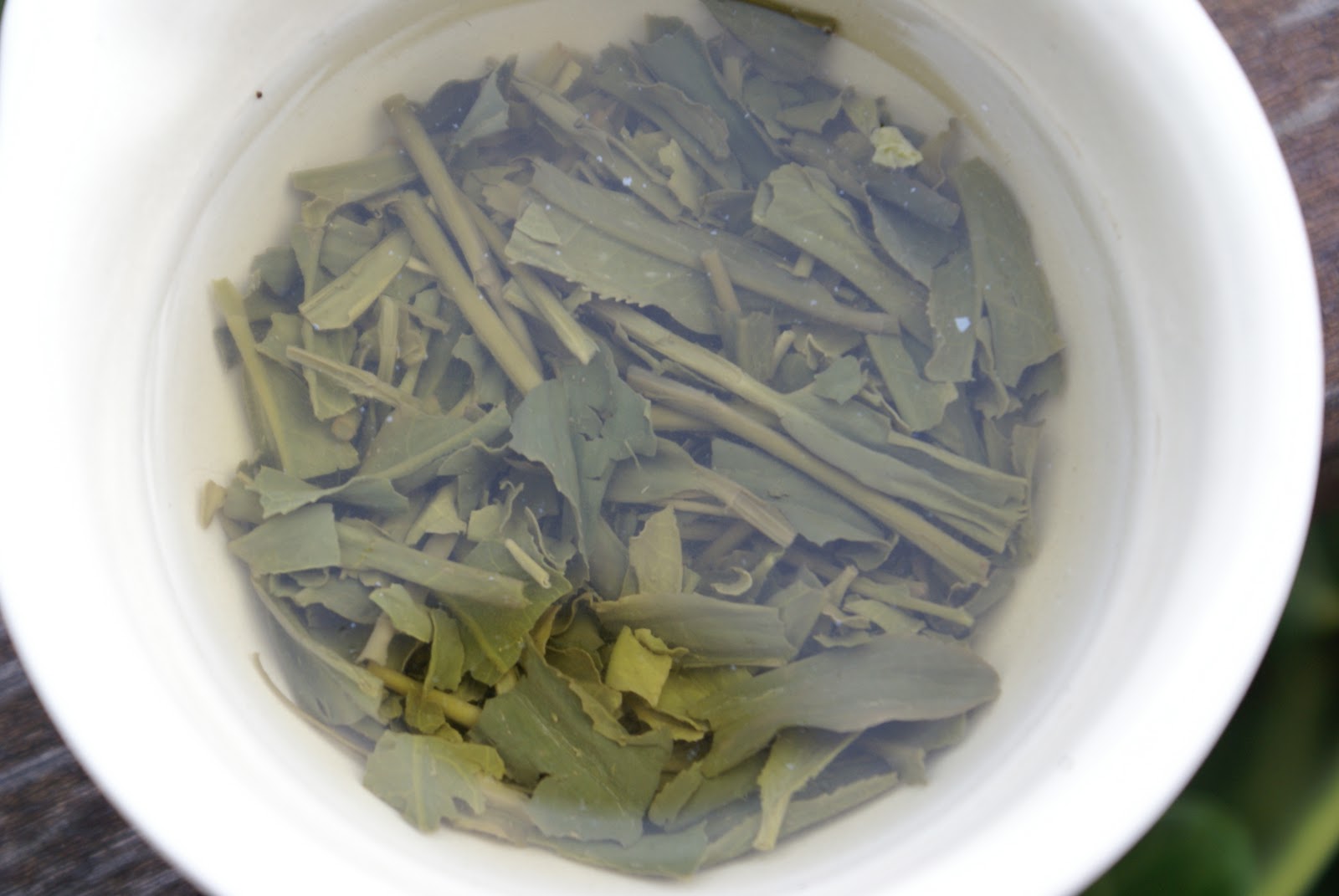 |
| These small delicate leaves will open completely even when infused with cold water. |
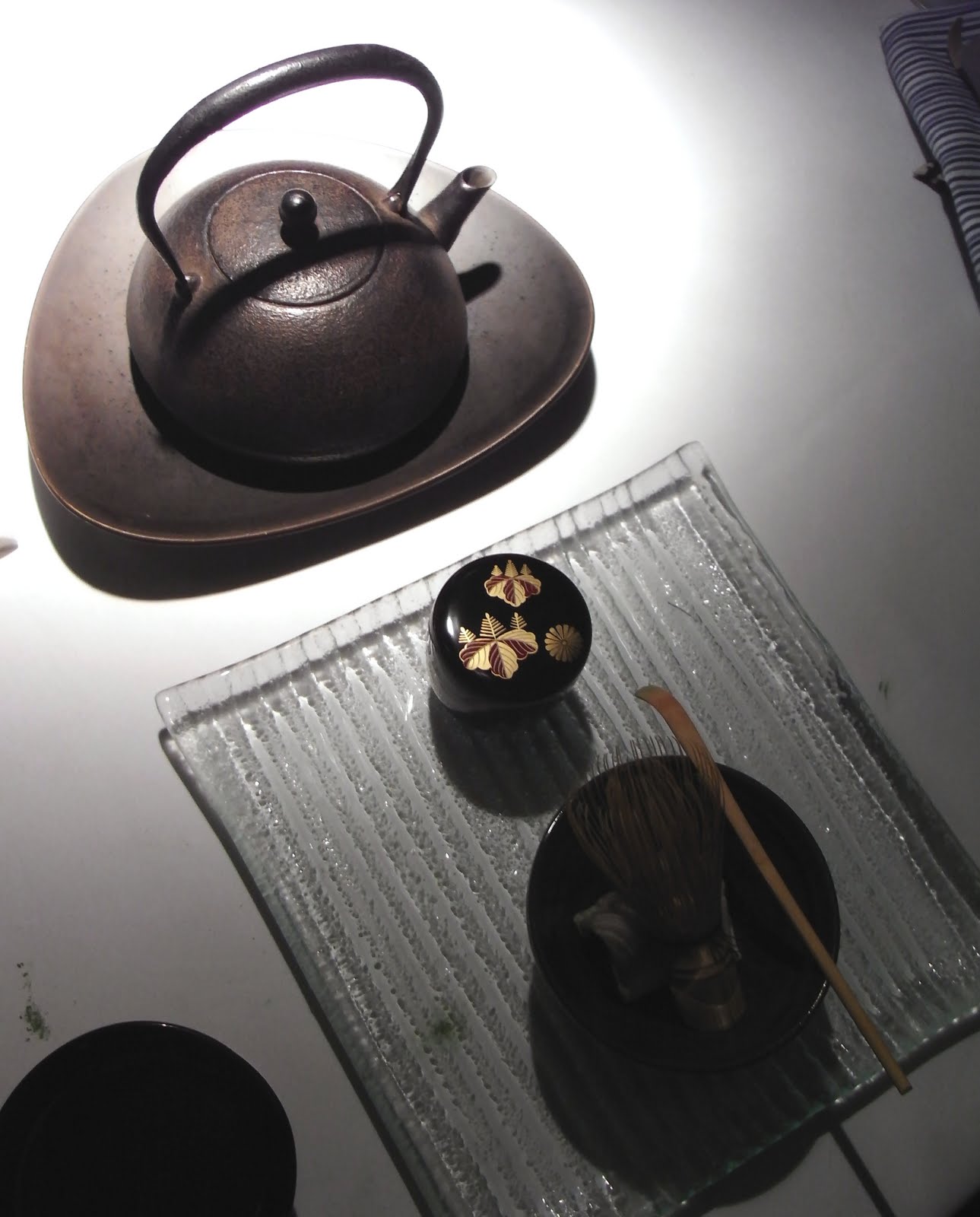 |
| Our modest chanoyu setup. |
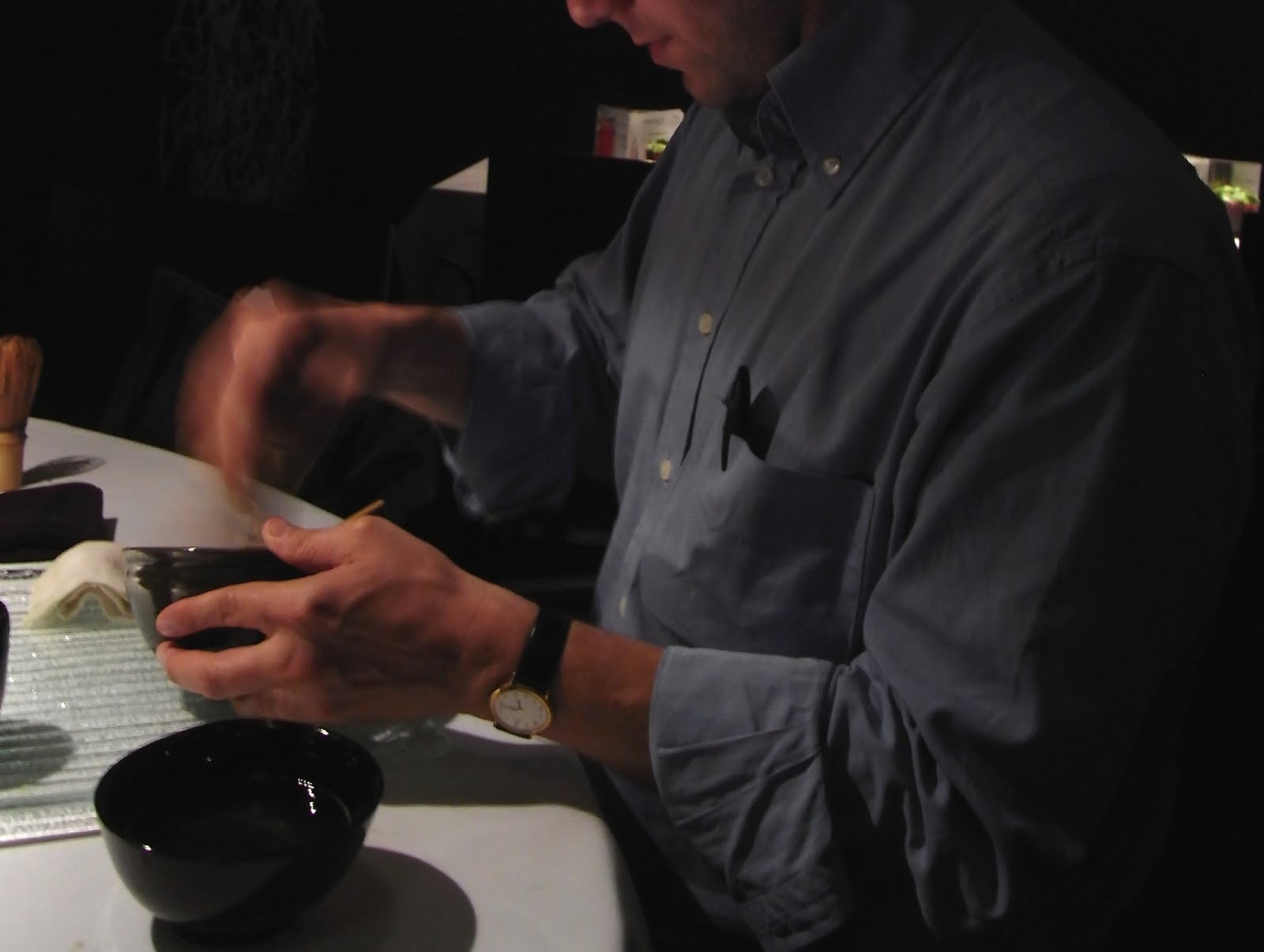 |
| Yours truly whisking duly. |
For those who read Japanese, Mr Hiruma has a website where his approach is explained. He is atypical in selling his own tea directly to consumers (Japanese tea is usually marketed by retailers, and is more often than not blended) and while mostly operating in Japan, he occasionally ships tea to the West with Paypal payment (contact him directly through the website for details). (See also this thread about Mr Hiruma on Teachat).
For all the teas below I have followed Mr Hiruma’s recommended brewing parameters. They are quite extreme, and crucially influencing the teas’ perception. While Japanese tea is usually brewed with medium-low dosage (2–3g of leaf per 100–150ml being the norm), Mr Hiruma advocates dosage as high as 5g / 50–60ml for some teas. That does make you raise an eyebrow. As an example, for the 3rd Prize Asamushi Sencha described below, it’s 5g / 60ml / 60C / 2 minutes. But actually only 34ml of liquid can be drained from the teapot (I’ve weighed this on an electronic scale), so it’s more of a ‘maceration’ than an actual brewing. It’s an approach that I’d call the gyokurization of sencha: a controversial policy, although it admittedly showcases the teas’ intensity and complexity on an unparalleled scale. Retrying some of the teas with more human parameters (usually 2.5g/100ml) yielded different results so please bear in mind that the below tasting notes are all taken with the Hiruma recommended parameters.
I started with two competition sencha teas. One Asamushi is a regional blend of Saitama and Mie leaves (Yabukita cultivar; two photos above), good-looking, sweet-vegetal, balanced, clean, voluminous with a fair bit of sweetness when brewed normally. With the recommended brewing parameters, the infusion is incredibly concentrated, magnifying the interplay between umami, sweetness, fatness and mild bitterness (the latter more pronounced as the tea cools down). The 3rd Prize Asamushi (also unblended Yabukita) is a more impressive grade, with immaculate short-steamed leaves that are extremely well-sorted. Little aroma in the cup with the recommended dosage of 5g/60ml, this is really outrageously concentrated with an explosion of flavour, dominated by sweetness over umami, later rounded off by some bitterish astringency; sweet over vegetal, long finish; there positively seems to be an added dimension of purity and intensity in this over the other competition asamushi.
One of the most memorable moments of these sessions was comparing four single-cultivar sencha teas alongside. Some of Mr Hiruma’s teas are blends of these (and several others), and it’s usual practice in Japan to operate a blend, unless your tea is from a wider-known variety such as the ubiquitous Yabukita, Yutakamidori (see a review here), Saemidori etc. Not only some of these Saitama-grown cultivars are fairly obscure (at least to me), but here is a rare opportunity to try them unblended. Put briefly, the differences in flavour and style are huge. The Fukumidori is processed as a rather highly fragmented fukamushi, with a strong spinach aroma and a Sauvignon-like profile of kiwi and lime; it gives a nicely tangy, zesty first brewing but fades quickly:
The Hokumei is sweeter, floral on nose and palate, almost milky in expression, with a very long finish; tasted blind I wouldn’t be sure this is sencha, it is so un-vegetal. The Sayamakaori is a chunky asamushi grade with kiwi tang and tannic potency in the flavour; more structured than charming, less sweet than the other varietals, this is a grown-up sencha that I’d qualify as austere. The most extraordinary, however, is the Yumewakaba: yielding a concentrated, creamy, almost almond milk-like brew with no astringency whatsoever, it is absolutely delightful.
 Apart from standard sencha teas I’ve also tasted several oddities here, including a top-grade 2009 Kukicha Fukamushi Honeppoi Yatsu (pictured above and right) that combines the familiar high-roasted flavours of kukicha (stem tea) with echoes of umami green tastes so typical of fukamushi; and the 2009 Sencha Asamushi Chakakacha that has some flower buds added to the blend contributing to a very elegant, juicy, fruity, mildly floral tea.
Apart from standard sencha teas I’ve also tasted several oddities here, including a top-grade 2009 Kukicha Fukamushi Honeppoi Yatsu (pictured above and right) that combines the familiar high-roasted flavours of kukicha (stem tea) with echoes of umami green tastes so typical of fukamushi; and the 2009 Sencha Asamushi Chakakacha that has some flower buds added to the blend contributing to a very elegant, juicy, fruity, mildly floral tea.
One of the most peculiar creations of Hiruma is the bihakkou sencha, a tea that’s allowed to wither for a very short time before being processed like a sencha. The result is a very slightly oolonged green tea whose aromatic register shifts from the vegetal towards the floral. In fact the orchid and lilac notes come very close to a Taiwanese Baozhong, and there is no bitterness or dryness whatsoever in the flavour.
I tried four of these: the Seikakou (Sayamakaori cultivar; bottom photo above) starts very flowery and also emulates the buttery texture of Baozhong but is a bit simplistic and coarse (recommended brewing temp of 90C might have caused that); the Hanayaka (Hokumei cultivar; top above photo) is the most floral of the three, and very smooth on the palate with a low-key, elegant flavour; the Tsuyayaka (Yumewakaba cultivar) is less floral, chunkier in style, but has a very pleasant sweet baked bread expression, and a successful fukamushi-like cloudy second brew; the Kobashicha (Yumewakaba cultivar) sees a higher roasting. These are very distinctive teas for Japan, and inexpensive @ ¥2,500 / 100g. (All Hiruma teas are very well-priced, generally speaking). Mr Hiruma recommends a lower dosage here: 3g for 90ml (70C). I’m told he also makes a full-throttle oolong style called hanhakkucha – now that would really be interesting to try.
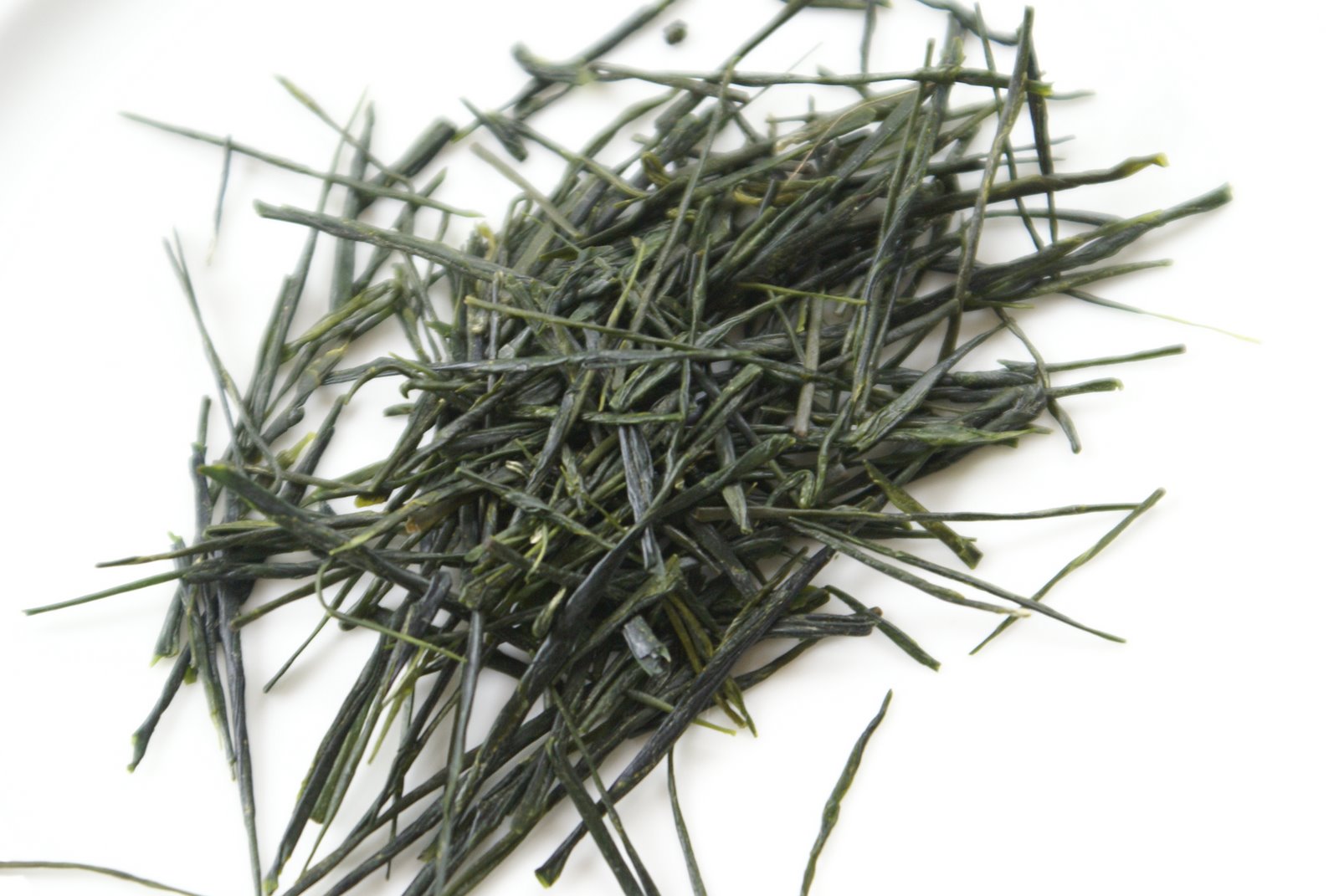
An exercise matching tea and chocolate. Can this work at all? Isn’t chocolate too powerful to have with tea? I try some artisanal chocolate pralines with green, oolong, black and puer tea.
An outstanding gyokuro, crystal-clear with fantastic depth of flavour.
Gyokuro: any other tea that triggers the same sense of excitement and festivity?
Other posts in this series:
2008 Gyokuro Kame-Jiru-Shi (O-Cha)
2008 Gyokuro Tama Homare (Marukyu)
2008 Kabusecha Takamado (Marukyu)
2008 Sencha Miyabi (O-Cha)
2009 Shincha Fukamushi Supreme (O-Cha)
2009 Shincha Shigaraki (Marukyu)
2009 Shincha Shuei (Marukyu)
2009 Shincha Uji Gold (Marukyu)
2009 Shincha Yutakamidori (O-Cha)
There are many aspects of the Japanese civilisation that I find totally incomprehensible (such as pachinko) and many others that I find highly admirable.
One such aspect is the pragmatic savviness that is applied to tea production. Unlike those crazy Chinese that insist on making tea from whole leaves and often conduct only one harvest per year, the Japanese really make their tea trees and leaves work hard for their living. From the most immaculate gyokuro to the lowliest genmaicha nothing is ever wasted and everything is produced with logic and order.
Your summer harvest has produced large leaves with no finesse and lots of bitterness? Roast them and sell cheaply to restaurants as bancha. Lots of substandard leaves in your sencha? Mix with puffed rice and a bit of tea powder for a good genmaicha. Gyokuro yields low and takes a long time to cash in? There’s always market for an earlier release of affordable kabusecha.
The Japanese tea tradition has also created a number of products made from material that elsewhere would be considered leftovers. Tea debris from the production of sencha or other grades make mecha and konacha. And then there are stems, stalks and twigs. Surely there’s the occasional twig in some oolongs (like the Young Tree Baozhong from Tea Masters), and most puer is made with leaves attached to the stems, but the latter’s amount remains marginal. Kukicha, on the other hand, is a Japanese speciality made mostly from stems with some addition of leaf; the whole is roasted and yields a rich, toasty, grainy infusion that is low in caffeine and reputed to be even healthier than ‘standard’ green tea. Here’s an image of a standard kukicha:
.jpg)
When the stems are a by-product of a higher grade material, the obtained tea is renamed karigane. Karigane is rarely roasted, so that you can taste the flavour of quality stems in its unadulterated sweetness and creaminess. Usually it is blended with a proportion of leaf for a richer taste.
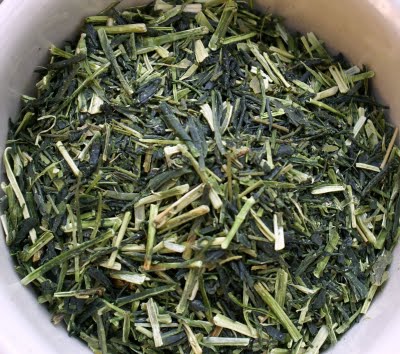
The 2008 Otowa Gyokuro-Karigane I am tasting today is yet another tea from the ever-so-reliable Marukyu-Koyamaen. It is the aristocracy of stem tea: tiny young tea shoots blended with gyokuro-grade leaf. The visual aspect is quite delightful and so is the aroma: spinach-vegetal but with a rounder, richer, almost white-chocolatey dimension than a leaf-only tea.
3g of Karigane separated into 0.9g of stems (left) and 2.1 of gyokuro-grade leaf (right).
Eager to find out more, I sacrificed an hour to separate the stems from the leaves in a 3g sample. It turns out that the former constitute less than half the material here (1/3 by weight, but they’re lighter than the leaves proper). Then I brewed these two fractions separately. The leaves are of excellent quality yielding a sweet, excitingly raspberry-scented, gyokuro-styled infusion. Really surprising. As for the stems, I expected the brew to be quite thin but in fact it is quite intense. Karigane is often described as ‘sweet’ and ‘creamy’ but these stems are giving a bone-dry, rather woodsy, dried-herby flavour. Interesting.

Infused karigane stems (top), karigane leaves (bottom left) and kukicha (bottom right).
It was not the end of my exploration. While centuries of practice and gazillions of reference points have contributed to setting the best infusion parameters for classic tea such as sencha and gyokuro, karigane is trickier. Should you brew it like the leaf it is based on? Or with hot water and longer times to extract the maximum from these tiny stems? I explored all the alternatives in a series of comparative tastings, and came up with the following table:
|
50C |
60C |
70C |
|
|
1 gram |
Light colour. Decent umami personality here but unintense. Not bad if you like your Japanese tea quite light. Only one good brewing. |
Moderate intensity even at this highish temperature. Unremarkable, plus the stale, seaweedy element dominates. |
|
|
2 grams |
Brews very light but the glutamic thickness is obvious. Really interesting how this develops more texture and sweetness than at higher temperatures. Lacks a bit of oomph if you like an ‘expressive’ tea, otherwise I found it as good as a higher dosage at this temperature. |
More aroma and intensity to the flavour than the 50C version but somehow loses thickness (because it isn’t extracted, or its perception is masked by the higher temperature of tea in cup?). A clear taste of umami and all in all a good compromise. I also like the 2nd brewing here. |
Very similar to the 60C version, again seems less thick than the 50C. Quite vegetal. 2nd brewing is OK. But no doubt this temperature is too high to obtain good extraction and balance. |
|
3 grams |
Good thickness but profile is less transparent than with 2 grams: umami clashes with spinach vegetality. A touch bitter. But also good sweetness. This dosage is OK if you want a proper session of 3–4 infusions. |
A deeper colour. At 70C this is quite more nutty than the 2-gram version. Less finesse and less interest. More vegetality than umami. Some interest to the second brew. |

One of my comparative tastings: 1, 2 and 3 grams of leaf (from left to right).
Having found out the best dosage (2g) and brewing temperature (60C) I went on to compare various brewing times:
|
1 minute |
2 minutes |
3 minutes |
|
Colour is pale but a nice brewing, good mixture of sweetness and umami, not too intense or long but there’s a glutinous kiss on the finish. Representative and there’s no need for a longer steeping. |
Little change to the 1-minute version apart from the colour and the stem influence: a more woodsy, herby taste. Sweetness is masked though, the whole is chunky and slightly lacks charm. |
Almost identical to the 2-minute version, as if the extraction stopped. Not very sweet and no more interest than the 1-minute. |

Colour of first infusion with ‘standard’ parameters (3g / 100ml / 60C / 60 seconds).
To summarise, this aristocratic karigane should be brewed like a gyokuro, with warm not hot water (55–60C seems best). 2 grams of leaf per 100ml of water is a good dosage; infusion times can vary but short ones (60 seconds) are pretty good.
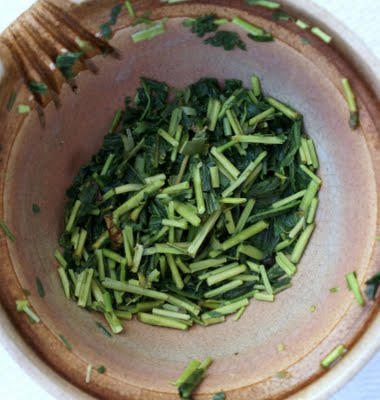
This is a truly interesting tea: I can’t remember spending so much time recently with a single tea, and I hardly got bored. It shows a bit of 2008 staleness to it (I identify it as dried herbs and seaweeds) but it’s not too obtrusive. The key is to brew it properly. Done sencha-style it is underwhelming with little personality, but gyokuro-style is a completely different animal. Little aroma but on the palate this erupts with glutamic density and length, with good sweetness and an added herby dimension from the leaf. A challenging taste if you’re not ‘of the school’ but impressive for sure. And at ¥1575 / 90g can it is really good value.